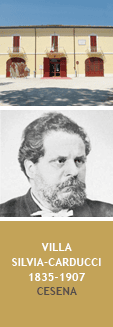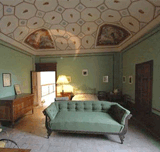Villa Silvia - Cesena
The Villa, dating back to the eighteenth century, became property of the countess Silvia Pasolini Zanelli in 1874; she held there a salon gathering the intelligentsia from Romagna: writers and journalists such as Nazareno Trovanelli, Paolo Amaducci and Antonio Messeri, or musicians like Balilla Pratella, Achille Turchi and Federico Sarti.
Among them were also the outstanding singer Alessandro Bonci whom the city theatre is dedicated, and the famous poet Giosuè Carducci.
Here Carducci spent long periods of holidays (eleven times between 1897 and 1906) enjoying not only the peace of the park and the mildness but also listening to the music played by the countess and talking to that leading spirit and highly-cultured woman. Here the poet was inspired to write the famous “Ode alla Chiesa di Polenta”; he got so involved with Villa Silvia as to wish that his days would end here. As a token of their bond a plaque remains: it was placed by the Pasolini Zanelli family in 1907, following the poet’s death, in everlasting memory of their admiration and friendship.
The room where Carducci used to live during his stays has remained untouched and can be visited: the furniture, most of his personal belongings and many pictures showing the poet at the Villa are still there.
The Countess Silvia died in 1920; she bequeathed to the town of Cesena the villa and the large green area that surrounds it to host a charitable institution in memory of her son Pietro and of Giosuè Carducci.
Since then and up to today Cesena Town hall has promoted various social and cultural initiatives: over the last fifty years there were a tubercular hospital for children, a nursery school, a recreation centre, other recreational activities and cultural events. Many activities are still taking place here. You can walk through the evocative “Giardino Letterario” surrounding the Villa: your visit will be supported by recorded music and voices telling news, information, anecdotes about the life of the countess and her ties with Carducci and the other frequent guests at the Villa.
Since 2007 the villa is the operative headquarters of the AMMI (Italian Association of Mechanical Music) engaged in dissemination, preservation and restoration of mechanical musical instruments; they hold educational activities for children, workshops and a school of restoration. Beside running one of the richest libraries on musical instruments in Europe, the AMMI has created here a really outstanding museum named “Musicalia”: a tale which takes you through seven rooms from the actual size model of the mechanical War Drum by Leonardo da Vinci to the twentieth century instruments, along five hundred years of music.
Among them were also the outstanding singer Alessandro Bonci whom the city theatre is dedicated, and the famous poet Giosuè Carducci.
Here Carducci spent long periods of holidays (eleven times between 1897 and 1906) enjoying not only the peace of the park and the mildness but also listening to the music played by the countess and talking to that leading spirit and highly-cultured woman. Here the poet was inspired to write the famous “Ode alla Chiesa di Polenta”; he got so involved with Villa Silvia as to wish that his days would end here. As a token of their bond a plaque remains: it was placed by the Pasolini Zanelli family in 1907, following the poet’s death, in everlasting memory of their admiration and friendship.
The room where Carducci used to live during his stays has remained untouched and can be visited: the furniture, most of his personal belongings and many pictures showing the poet at the Villa are still there.
The Countess Silvia died in 1920; she bequeathed to the town of Cesena the villa and the large green area that surrounds it to host a charitable institution in memory of her son Pietro and of Giosuè Carducci.
Since then and up to today Cesena Town hall has promoted various social and cultural initiatives: over the last fifty years there were a tubercular hospital for children, a nursery school, a recreation centre, other recreational activities and cultural events. Many activities are still taking place here. You can walk through the evocative “Giardino Letterario” surrounding the Villa: your visit will be supported by recorded music and voices telling news, information, anecdotes about the life of the countess and her ties with Carducci and the other frequent guests at the Villa.
Since 2007 the villa is the operative headquarters of the AMMI (Italian Association of Mechanical Music) engaged in dissemination, preservation and restoration of mechanical musical instruments; they hold educational activities for children, workshops and a school of restoration. Beside running one of the richest libraries on musical instruments in Europe, the AMMI has created here a really outstanding museum named “Musicalia”: a tale which takes you through seven rooms from the actual size model of the mechanical War Drum by Leonardo da Vinci to the twentieth century instruments, along five hundred years of music.








